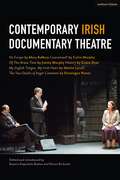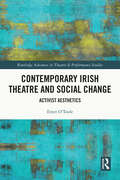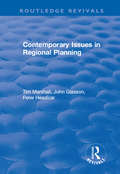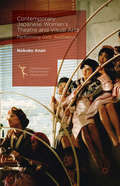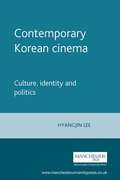- Table View
- List View
Contemporary Illumination for the Calligrapher and Artist: Traditional Techniques Reinterpreted
by Toni WattsContemporary Illumination gives detailed instruction for artists wishing to add gold leaf to their work. It explains the techniques used in medieval manuscripts but shows how these same techniques can be used to stunning effect to enhance lettering and paintings in contemporary styles. Alongside step-by-step instruction, it also gives practical advice on how to fix common problems. For both the novice and the more experienced, this handsome book unlocks illuminated secrets from the fifteenth century and shows how they can be applied just as beautifully to art of today. With fully illustrated step-by-step instructions for gilding and painting using readily available off-the-shelf products. For those with more experience, there are detailed instructions on the making and use of both manuscript gesso and shell gold, with examples of how they might be used both to enhance a calligraphic text as well as a painting or drawing. There are also suggestions of how to paint on gold, and how to combine flat and raised gilding in new and innovative ways. This book is a visual treat and an invaluable guide for everyone who wants to appreciate the art of illumination and to learn how to use traditional techniques in contemporary applications.
Contemporary Indian Dance: New Creative Choreography in India and the Diaspora (Studies in International Performance)
by K. KatrakThrough discussion of a dazzling array of artists in India and the diaspora, this book delineates a new language of dance on the global stage. Myriad movement vocabularies intersect the dancers' creative landscape, while cutting-edge creative choreography parodies gender and cultural stereotypes, and represents social issues.
Contemporary Indonesian Fashion: Through the Looking Glass (Dress and Fashion Research)
by Alessandra Lopez y RoyoIndonesian fashion has undergone a period of rapid growth over the last three decades. This book explores how through years of social, political, and cultural upheaval, the country's fashion has moved away from “colonial fashion” and “national dress” to claim its own distinct identity as contemporary fashion in a global world.With specific reference to women's wear, Contemporary Indonesian Fashion explores the diversity and complexity of the country's sartorial offerings, which weave together local textile traditions like batik and ikat-making with contemporary narratives. The book questions concepts of “tradition” and “modernity” in the developing world, taking stock of the elite consumption of luxury brands and the large-scale manufacturing of fast fashion, and introduces us to the rise of new trends such as busana muslim (or “modest wear”), creating a portrait of a vibrant and growing national and, increasingly, international, industry.Exploring clothing in shopping malls, on the catwalk, in magazines, and online, the book examines how Indonesian fashion is made, presented, and consumed, combining research in Indonesia with analysis and personal reflection. Contemporary Indonesian Fashion ultimately questions the deeply entrenched eurocentrism of "global fashion", simultaneously interrogating current homogenizing beauty and body image discourses posited as universal, by pointing to absences, silences, and erasures as reflected by contemporary Indonesian fashion- hence the "looking glass" of the title. Aptly illustrated, the book offers a new perspective on a rapidly developing new fashion capital, Jakarta.
Contemporary Indonesian Fashion: Through the Looking Glass (Dress and Fashion Research)
by Alessandra Lopez y RoyoIndonesian fashion has undergone a period of rapid growth over the last three decades. This book explores how through years of social, political, and cultural upheaval, the country's fashion has moved away from “colonial fashion” and “national dress” to claim its own distinct identity as contemporary fashion in a global world.With specific reference to women's wear, Contemporary Indonesian Fashion explores the diversity and complexity of the country's sartorial offerings, which weave together local textile traditions like batik and ikat-making with contemporary narratives. The book questions concepts of “tradition” and “modernity” in the developing world, taking stock of the elite consumption of luxury brands and the large-scale manufacturing of fast fashion, and introduces us to the rise of new trends such as busana muslim (or “modest wear”), creating a portrait of a vibrant and growing national and, increasingly, international, industry.Exploring clothing in shopping malls, on the catwalk, in magazines, and online, the book examines how Indonesian fashion is made, presented, and consumed, combining research in Indonesia with analysis and personal reflection. Contemporary Indonesian Fashion ultimately questions the deeply entrenched eurocentrism of "global fashion", simultaneously interrogating current homogenizing beauty and body image discourses posited as universal, by pointing to absences, silences, and erasures as reflected by contemporary Indonesian fashion- hence the "looking glass" of the title. Aptly illustrated, the book offers a new perspective on a rapidly developing new fashion capital, Jakarta.
Contemporary Irish Documentary Theatre
by Mary Raftery Colin Murphy Jimmy Murphy Martin Lynch Domingos Nunez Grace DyasContemporary Irish Documentary Theatre is the first anthology of Irish documentary drama. It features five challenging plays by Irish writers, and one by an international author, interrogating and commenting on crucial events of Irish history and of the diaspora, with introductory essays by established academics. Together these plays represent the most innovative development in contemporary Irish theatre and illuminate the social and political realities of contemporary Ireland. The first two plays, of 2010 and 2013, deal with scandals of clerical and institutional abuse, and use as source material the Ryan Report of 2009, and the documents from the 2008 Irish Bank Guarantee. The next two, of 2014 and 2013, concern interpretations of the most iconic moment of Irish history: the Easter Rising. The first of these is based on published statements of participants in the event and the second on the lived experiences of those in the contemporary Republic whose founding ideals have not been realized . The last two plays, of 2015 and 2016, widen the view to the history of the Irish in the diaspora: one retelling the history of emigration to England based on published research material; and the other tracing Roger Casement's experiences in the Amazon and his subsequent participation in the Easter Rising using extracts from his diaries and other writings.The plays included and discussed are: No Escape by Mary RafteryGuaranteed by Colin MurphyOf This Brave Time by Jimmy MurphyHistory by Grace DyasMy English Tongue, My Irish Heart by Martin LynchThe Two Deaths of Roger Casement by Domingos Nunez
Contemporary Irish Documentary Theatre
by Mary Raftery Colin Murphy Jimmy Murphy Martin Lynch Domingos Nunez Grace DyasContemporary Irish Documentary Theatre is the first anthology of Irish documentary drama. It features five challenging plays by Irish writers, and one by an international author, interrogating and commenting on crucial events of Irish history and of the diaspora, with introductory essays by established academics. Together these plays represent the most innovative development in contemporary Irish theatre and illuminate the social and political realities of contemporary Ireland. The first two plays, of 2010 and 2013, deal with scandals of clerical and institutional abuse, and use as source material the Ryan Report of 2009, and the documents from the 2008 Irish Bank Guarantee. The next two, of 2014 and 2013, concern interpretations of the most iconic moment of Irish history: the Easter Rising. The first of these is based on published statements of participants in the event and the second on the lived experiences of those in the contemporary Republic whose founding ideals have not been realized . The last two plays, of 2015 and 2016, widen the view to the history of the Irish in the diaspora: one retelling the history of emigration to England based on published research material; and the other tracing Roger Casement's experiences in the Amazon and his subsequent participation in the Easter Rising using extracts from his diaries and other writings.The plays included and discussed are: No Escape by Mary RafteryGuaranteed by Colin MurphyOf This Brave Time by Jimmy MurphyHistory by Grace DyasMy English Tongue, My Irish Heart by Martin LynchThe Two Deaths of Roger Casement by Domingos Nunez
Contemporary Irish Poetry: A Collection of Critical Essays
by Elmer AndrewsContains 14 essays dealing with the poetry that has come out of Ireland since the mid-1960s. The first half of the book is devoted to general issues and themes, and takes account of the interrelationships of contemporary Irish poetry. The second half concentrates on the work of individual poets.
Contemporary Irish Popular Culture: Transnationalism, Regionality, and Diaspora
by Anthony P. McIntyreThis book uses popular culture to highlight the intersections and interplay between ideologies, technological advancement and mobilities as they shape contemporary Irish identities. Marshalling case studies drawn from a wide spectrum of popular culture, including the mediated construction of prominent sporting figures, Troubles-set sitcom Derry Girls, and poignant drama feature Philomena, Anthony P. McIntyre offers a wide-ranging discussion of contemporary Irishness, tracing its entanglement with notions of mobility, regionality and identity. The book will appeal to students and scholars of Irish studies, cultural studies, as well as film and media studies.
Contemporary Irish Theatre: Histories and Theories
by Ian R. Walsh Charlotte McIvorThis open access book is a new survey of theatre practices in Ireland from 1957 to the present. Part I: Histories, situates the theatrical activity of twentieth and twenty-first century Ireland within its social and political contexts, identifies key practitioners, landmark productions, institutions, festivals, and seminal revivals. Part II: Theories, offers five key theoretical frameworks - nation, language, body, space and interculturalism - to examine contemporary Irish theatre practices. Contemporary Irish Theatre and Performance ultimately offers a more extensive story of contemporary Irish theatre documenting the diversity of practices and contributors that have populated the contemporary Irish theatre landscape since 1957.
Contemporary Irish Theatre and Social Change: Activist Aesthetics (Routledge Advances in Theatre & Performance Studies)
by Emer O'TooleThis book uses the social transformation that has taken place in Ireland from the decriminalisation of homosexuality in 1993 to the repeal of the 8th amendment in 2018 as backdrop to examine relationships between activism and contemporary Irish theatre and performance. It studies art explicitly intended to create social and political change for marginalised constituencies. It asks what happens to theatre aesthetics when artists’ aims are political and argues that activist commitments can create new modes of beauty, meaning, and affect. Categories of race, class, sexuality, and gender frame chapters, provide social context, and identify activist artists’ social targets. This book provides in depth analysis of: Arambe – Ireland’s first African theatre company; THEATREclub – an experimental collective with issues of class at its heart; The International Dublin Gay Theatre Festival; and feminist artists working to Repeal the 8th amendment. It highlights the aesthetic strategies that emerge when artists set their sights on justice. Aesthetic debates, both historical and contemporary, are laid out from first principles, inviting readers to situate themselves – whether as artists, activists, or scholars – in the delicious tension between art and life. This book will be a vital guide to students and scholars interested in theatre and performance studies, gender studies, Irish history, and activism.
Contemporary Irish Theatre and Social Change: Activist Aesthetics (Routledge Advances in Theatre & Performance Studies)
by Emer O'TooleThis book uses the social transformation that has taken place in Ireland from the decriminalisation of homosexuality in 1993 to the repeal of the 8th amendment in 2018 as backdrop to examine relationships between activism and contemporary Irish theatre and performance. It studies art explicitly intended to create social and political change for marginalised constituencies. It asks what happens to theatre aesthetics when artists’ aims are political and argues that activist commitments can create new modes of beauty, meaning, and affect. Categories of race, class, sexuality, and gender frame chapters, provide social context, and identify activist artists’ social targets. This book provides in depth analysis of: Arambe – Ireland’s first African theatre company; THEATREclub – an experimental collective with issues of class at its heart; The International Dublin Gay Theatre Festival; and feminist artists working to Repeal the 8th amendment. It highlights the aesthetic strategies that emerge when artists set their sights on justice. Aesthetic debates, both historical and contemporary, are laid out from first principles, inviting readers to situate themselves – whether as artists, activists, or scholars – in the delicious tension between art and life. This book will be a vital guide to students and scholars interested in theatre and performance studies, gender studies, Irish history, and activism.
Contemporary Israeli Cinema: Trauma, Ethics and Temporality (Routledge Studies in Middle East Film and Media)
by Raz YosefThrough analysis of the complex discourse surrounding trauma and loss, this book provides a necessary examination of temporality and ethics in Israeli film and television since the turn of the millennium. The author examines posttraumatic idioms of fragmentation and incoherence, highlighting the rising resistance towards generic categories, and the turn to unconventional and paradoxical structures with unique aesthetics. Maintaining that contemporary Israeli cinema has undergone an ethical shift, the author examines the revealing traumas and denied identities that also seek alternative ways to confront ethical question of accountability. It discusses the relationships between trauma, nationalism, and cinema through the intertwined perspectives of feminism, queer theory, and critical race and postcolonial studies, showing how national traumas are constructed by notions of gendered, sexual, and racial identity. This innovative text highlights the complexities of discourse surrounding trauma and loss, informed by multiple categories of difference. Across each chapter various elements of Israeli film are explored, spanning from strategies used to critically examine victim-perpetrator dynamics, co-existence in temporal space, women’s cinema in Israel, displacement, and queer communities and identity. Beyond its direct contribution to cinema studies and Israel studies, the book will be of interest to trauma and memory studies, postcolonial studies, gender and sexuality studies, Jewish studies, Middle Eastern studies, and cultural studies.
Contemporary Israeli Cinema: Trauma, Ethics and Temporality (Routledge Studies in Middle East Film and Media)
by Raz YosefThrough analysis of the complex discourse surrounding trauma and loss, this book provides a necessary examination of temporality and ethics in Israeli film and television since the turn of the millennium. The author examines posttraumatic idioms of fragmentation and incoherence, highlighting the rising resistance towards generic categories, and the turn to unconventional and paradoxical structures with unique aesthetics. Maintaining that contemporary Israeli cinema has undergone an ethical shift, the author examines the revealing traumas and denied identities that also seek alternative ways to confront ethical question of accountability. It discusses the relationships between trauma, nationalism, and cinema through the intertwined perspectives of feminism, queer theory, and critical race and postcolonial studies, showing how national traumas are constructed by notions of gendered, sexual, and racial identity. This innovative text highlights the complexities of discourse surrounding trauma and loss, informed by multiple categories of difference. Across each chapter various elements of Israeli film are explored, spanning from strategies used to critically examine victim-perpetrator dynamics, co-existence in temporal space, women’s cinema in Israel, displacement, and queer communities and identity. Beyond its direct contribution to cinema studies and Israel studies, the book will be of interest to trauma and memory studies, postcolonial studies, gender and sexuality studies, Jewish studies, Middle Eastern studies, and cultural studies.
Contemporary Issues in Regional Planning (Routledge Revivals)
by John GlassonThis title was first published in 2002: Regional planning and government in the UK is undergoing a period of tremendous activity, with a wide range of new policies, innovative techniques and experiments being tested. This volume provides an overview of developments, describing and analyzing the legislative, political and economic contexts within which changes are occurring, and assessing the continuing difficulties that face planners and others operating in the new arrangements for regional planning
Contemporary Issues in Regional Planning (Routledge Revivals)
by John GlassonThis title was first published in 2002: Regional planning and government in the UK is undergoing a period of tremendous activity, with a wide range of new policies, innovative techniques and experiments being tested. This volume provides an overview of developments, describing and analyzing the legislative, political and economic contexts within which changes are occurring, and assessing the continuing difficulties that face planners and others operating in the new arrangements for regional planning
Contemporary Japanese Architecture: Tracing the Next Generation
by James SteeleContemporary Japanese Architecture presents a clear and comprehensive overview of the historical and cultural framework that informs the work of all Japanese architects, as an introduction to an in-depth investigation of the challenges now occupying the contemporary designers who will be the leaders of the next generation. It separates out the young generation of Japanese architects from the crowded, distinguished, multi-generational field they seek to join, and investigates the topics that absorb them, and the critical issues they face within the new economic reality of Japan and a shifting global order. Salient points in the text are illustrated by beautiful, descriptive images provided by the architects and from the extensive collection of the author. By combining illustrations with timelines and graphics to explain complex ideas, the book is accessible to any student seeking to understand contemporary Japanese architecture.
Contemporary Japanese Architecture: Tracing the Next Generation
by James SteeleContemporary Japanese Architecture presents a clear and comprehensive overview of the historical and cultural framework that informs the work of all Japanese architects, as an introduction to an in-depth investigation of the challenges now occupying the contemporary designers who will be the leaders of the next generation. It separates out the young generation of Japanese architects from the crowded, distinguished, multi-generational field they seek to join, and investigates the topics that absorb them, and the critical issues they face within the new economic reality of Japan and a shifting global order. Salient points in the text are illustrated by beautiful, descriptive images provided by the architects and from the extensive collection of the author. By combining illustrations with timelines and graphics to explain complex ideas, the book is accessible to any student seeking to understand contemporary Japanese architecture.
Contemporary Japanese Cinema Since Hana-Bi: Theme, Style, Genre (Traditions in World Cinema)
by Adam BinghamThis book looks at some of the key genres in Japanese cinema since 1997. In several cases it considers in detail the ways in which individual films have both drawn and departed from those films that have comprised the key works and trends in these generic categories, and in others it looks at some significant recent developments that have little real precedence in filmmaking in Japan. Through close textual analysis of representative films, the study seeks to elucidate the prevalence of repetition and variation in contemporary Japanese genre cinema, to understand some of the reasons behind this paradigm, and analyze where relevant how and to what extent new modes or generic groups fit into the schema. In so doing it seeks for the first time in English language discourse to offer an academic appreciation and overview of popular Japanese of the last two decades.
Contemporary Japanese Cinema Since Hana-Bi: Theme, Style, Genre (Traditions in World Cinema)
by Adam BinghamThis book looks at some of the key genres in Japanese cinema since 1997. In several cases it considers in detail the ways in which individual films have both drawn and departed from those films that have comprised the key works and trends in these generic categories, and in others it looks at some significant recent developments that have little real precedence in filmmaking in Japan. Through close textual analysis of representative films, the study seeks to elucidate the prevalence of repetition and variation in contemporary Japanese genre cinema, to understand some of the reasons behind this paradigm, and analyze where relevant how and to what extent new modes or generic groups fit into the schema. In so doing it seeks for the first time in English language discourse to offer an academic appreciation and overview of popular Japanese of the last two decades.
Contemporary Japanese Women’s Theatre and Visual Arts: Performing Girls’ Aesthetics (Contemporary Performance InterActions)
by Nobuko AnanThis book traces the history of 'girls' aesthetics,' where adult Japanese women create art works about 'girls' that resist motherhood, from the modern to the contemporary period and their manifestation in Japanese women's theatrical and dance performance and visual arts including manga, film, and installation arts.
Contemporary Korean cinema: Culture, identity and politics
by Hyangjin LeeThe first in-depth, comprehensive study of Korean cinema offering original insight into the relationships between ideology and the art of cinema from East Asian perspectives. Combines issues of contemporary Korean culture and cinematic representation of the society and people in both North and South Korea. Covers the introduction of motion pictures in 1903, Korean cinema during the Japanese colonial period (1910-45) and the development of North and South Korean cinema up to the 1990s. Introduces the works of Korea’s major directors, and analyses the Korean film industry in terms of film production, distribution and reception. Based on this historical analysis, the study investigates ideological constructs in seventeen films, eight from North Korea and nine from South Korea.
Contemporary Landscape Performance Methods and Techniques: Lessons from the Houston Arboretum and Nature Center (Routledge Research in Landscape and Environmental Design)
by Galen Newman Rui Zhu Dongying Li Megan BarnesThis book defines, illustrates, applies, and explores current and future tools and methods for measuring landscape performance using the Houston Arboretum and Nature Center (HANC) as a case site, providing the most extensive, comprehensive description and application of existing landscape performance tools in the current literature to date.Landscape performance is a measure of the effectiveness with which landscape solutions fulfill their intended purpose and contribute to sustainability. The design of the HANC is a prime case for measuring landscape performance as the site has undergone a pervasive transformation of its 65-acre core as an initial phase of improvements. The massive six-year effort has reconfigured arrival, circulation, and parking, developed new educational facilities, constructed a network of walks and trails, and established sustainable ecologies of prairie, savannah, riparian woods, and upland woods across the northern half of its property. This book uses landscape performance as an integral method of not only blending science into the design process but using scientific outputs as the rationale for design-decision-making. Through this, the book showcases a multitude of proven quantitative and qualitative evaluation methods which can be applied to other designs and plans, calculating their specific impacts on the HANC, and guiding readers through how to use each tool through an applied process. This book provides a comprehensive set of tools and approaches to measuring landscape performance that could be used as a guide for other projects to replicate or expand upon.The book helps move the design professions beyond simple stereotypes of simple beauty of form, showcasing and describing how the design professions (primarily landscape architecture) are an extremely scientific and evidence-based industry.
Contemporary Landscape Performance Methods and Techniques: Lessons from the Houston Arboretum and Nature Center (Routledge Research in Landscape and Environmental Design)
This book defines, illustrates, applies, and explores current and future tools and methods for measuring landscape performance using the Houston Arboretum and Nature Center (HANC) as a case site, providing the most extensive, comprehensive description and application of existing landscape performance tools in the current literature to date.Landscape performance is a measure of the effectiveness with which landscape solutions fulfill their intended purpose and contribute to sustainability. The design of the HANC is a prime case for measuring landscape performance as the site has undergone a pervasive transformation of its 65-acre core as an initial phase of improvements. The massive six-year effort has reconfigured arrival, circulation, and parking, developed new educational facilities, constructed a network of walks and trails, and established sustainable ecologies of prairie, savannah, riparian woods, and upland woods across the northern half of its property. This book uses landscape performance as an integral method of not only blending science into the design process but using scientific outputs as the rationale for design-decision-making. Through this, the book showcases a multitude of proven quantitative and qualitative evaluation methods which can be applied to other designs and plans, calculating their specific impacts on the HANC, and guiding readers through how to use each tool through an applied process. This book provides a comprehensive set of tools and approaches to measuring landscape performance that could be used as a guide for other projects to replicate or expand upon.The book helps move the design professions beyond simple stereotypes of simple beauty of form, showcasing and describing how the design professions (primarily landscape architecture) are an extremely scientific and evidence-based industry.
Contemporary Latin American Cinema: Resisting Neoliberalism?
by Claudia Sandberg Carolina RochaContemporary Latin American Cinema investigates the ways in which neoliberal measures of privatization, de-regularization and austerity introduced in Latin America during the 1990s have impacted film production and film narratives. The collection examines the relationship between economic policies and the films that depict recent transformations in many Latin American countries, demonstrating how contemporary Latin American film has not only criticized and resisted, but also benefitted from neoliberal advancements. Based on films produced in Argentina, Bolivia, Brazil, Chile, Colombia, Ecuador, Mexico and Peru since 2010, the fourteen case studies illustrate neoliberalism’s effects, from big industries to small national cinemas. It also shows the new types of producers that have emerged, and the novel patterns of distribution, exhibition and consumption that shape and influence the Latin American filmscape. Through industry studies, reception analyses and close readings, this book establishes an informative and accessible text for scholars and students alike.
Contemporary Latin American Cinema: Resisting Neoliberalism?
by Claudia Sandberg Carolina RochaContemporary Latin American Cinema investigates the ways in which neoliberal measures of privatization, de-regularization and austerity introduced in Latin America during the 1990s have impacted film production and film narratives. The collection examines the relationship between economic policies and the films that depict recent transformations in many Latin American countries, demonstrating how contemporary Latin American film has not only criticized and resisted, but also benefitted from neoliberal advancements. Based on films produced in Argentina, Bolivia, Brazil, Chile, Colombia, Ecuador, Mexico and Peru since 2010, the fourteen case studies illustrate neoliberalism’s effects, from big industries to small national cinemas. It also shows the new types of producers that have emerged, and the novel patterns of distribution, exhibition and consumption that shape and influence the Latin American filmscape. Through industry studies, reception analyses and close readings, this book establishes an informative and accessible text for scholars and students alike.




